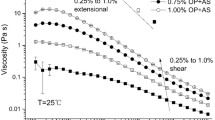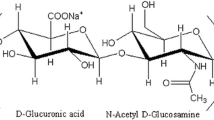Abstract
Objectives
To investigate the viscosity values of mixtures of hyaluronic acids with different molecular weights and the effects of these mixtures on the enzymatic activities of lysozyme and peroxidase.
Materials and methods
Mixtures of high molecular weight (1 or 2 MDa) and low molecular weight (10 or 100 kDa) hyaluronic acids at different concentrations were used for viscosity measurements. Hyaluronic acid mixtures showing viscosity values similar to those of human whole saliva were used for enzyme experiments in solution and on hydroxyapatite surface. Hen egg-white lysozyme, bovine lactoperoxidase, and human whole saliva were used as enzyme sources. Lysozyme activity was measured by hydrolysis of fluorescein-labeled Micrococcus lysodeikticus. Peroxidase activity was measured by oxidation of fluorogenic 2′,7′-dichlorofluorescein to fluorescing 2′,7′-dichlorofluorescein.
Results
The mixtures of 1 MDa (0.5 mg/mL) or 2 MDa (0.2 mg/mL) hyaluronic acid with 10 kDa (2.0 mg/mL) or 100 kDa (0.1 mg/mL) hyaluronic acid had viscosity values similar to those of human whole saliva at shear rates, reflecting normal oral functions. Compared with single molecular weight hyaluronic acids, these mixtures showed viscosity values more similar to those of human whole saliva. The mixtures inhibited lysozyme and peroxidase activities on the hydroxyapatite surfaces; however, the degree of inhibition did not differ from that of hyaluronic acid of 1 or 2 MDa only.
Conclusions
Compared with single molecular weight hyaluronic acids, hyaluronic acid mixtures showed viscosity values more similar to those of human whole saliva, without additional inhibitory effects on lysozyme and peroxidase activities.
Clinical relevance
Hyaluronic acid mixtures offer distinct advantages for the development of saliva substitutes.




Similar content being viewed by others
References
Almond A (2007) Hyaluronan. Cell Mol Life Sci 64:1591–1596
Luo Y, Kirker RK, Prestwich GD (2000) Cross-linked hyaluronic acid hydrogel films: new biomaterials for drug delivery. J Control Release 69:169–184
Pogrel MA, Lowe MA, Stern R (1996) Hyaluronan (hyaluronic acid) in human saliva. Arch Oral Biol 41:667–671
Pogrel MA, Low MA, Stern R (2003) Hyaluronan (hyaluronic acid) and its regulation in human saliva by hyaluronidase and its inhibitors. J Oral Sci 45:85–91
Park MS, Chang JY, Kang JH, Park KP, Kho HS (2010) Rheological properties of hyaluronic acid and its effects on salivary enzymes and Candida. Oral Dis 16:382–387
Sakai A, Akifusa S, Itano N, Kimata K, Kawamura T, Koseki T, Takehara T, Nishihara T (2007) Potential role of high molecular weight hyaluronan in the anti-Candida activity of human oral epithelial cells. Med Mycol 45:73–79
Kang JH, Kim YY, Chang JY, Kho HS (2011) Influences of hyaluronic acid on the anticandidal activities of lysozyme and the peroxidase system. Oral Dis 17:577–583
Cho MA, Kim YY, Chang JY, Kho HS (2013) Interactions between hyaluronic acid, lysozyme, and the glucose oxidase-mediated lactoperoxidase system in enzymatic and candidacidal activities. Arch Oral Biol 58:1349–1356
Kim J, Chang JY, Kim YY, Kim MJ, Kho HS (2018) Effects of molecular weight of hyaluronic acid on its viscosity and enzymatic activities of lysozyme and peroxidase. Arch Oral Biol 89:55–64
Hannig C, Spitzmüller B, Knausenberger S, Hoth-Hannig W, Hellwig E, Hannig M (2008) Detection and activity of peroxidase in the in situ formed enamel pellicle. Arch Oral Biol 53:849–858
Proctor GB, Chan KM (1994) A fluorometric assay of peroxidase activity utilizing 2′, 7′-dichlorofluorescein with thiocyanate: application to the study of salivary secretion. J Biochem Biophys Methods 28:69–76
Balmer RT, Hirsch SR (1978) The non-Newtonian behaviour of human saliva. Biorheology (AIChE Symposium Series) 181(74):125–129
Kho HS, Park MS, Chang JY, Kim YY (2014) Yam tuber mucilage as a candidate substance for saliva substitute: in vitro study of its viscosity and influences on lysozyme and peroxidase activities. Gerodontology 31:34–41
Park MS, Chung JW, Kim YK, Chung SC, Kho HS (2007) Viscosity and wettability of animal mucin solutions and human saliva. Oral Dis 13:181–186
Green SP, Baker MS, Lowther DA (1990) Depolymerization of synovial fluid hyaluronic acid (HA) by the complete myeloperoxidase (MPO) system may involve the formation of a HA-MPO ionic complex. J Rheumatol 17:1670–1675
Morfin I, Buhler E, Cousin F, Grillo I, Boué F (2011) Rodlike complexes of a polyelectrolyte (hyaluronan) and a protein (lysozyme) observed by SANS. Biomacromolecules 12:859–870
Moss JM, Van Damme MP, Murphy WH, Preston BN (1997) Dependence of salt concentration on glycosaminoglycan-lysozyme interactions in cartilage. Arch Biochem Biophys 348:49–55
Van Damme MP, Moss JM, Murphy WH, Preston BN (1991) Binding of hyaluronan to lysozyme at various pHs and salt concentrations. Biochem Int 24:605–613
Van Damme MP, Moss JM, Murphy WH, Preston BN (1994) Binding properties of glycosaminoglycans to lysozyme-effect of salt and molecular weight. Arch Biochem Biophys 310:16–24
Water JJ, Schack MM, Velazquez-Campoy A, Maltesen MJ, van de Weert M, Jorgensen L (2014) Complex coacervates of hyaluronic acid and lysozyme: effect on protein structure and physical stability. Eur J Pharm Biopharm 88:325–331
Embery G, Rölla G, Stanbury JB (1979) Interaction of acid glycosaminoglycans (mucopolysaccharides) with hydroxyapatite. Scand J Dent Res 87:318–324
Mavropoulos E, Costa AM, Costa LT, Achete CA, Mello A, Granjeiro JM, Rossi AM (2011) Adsorption and bioactivity studies of albumin onto hydroxyapatite surface. Colloids Surf B Biointerfaces 83:1–9
Lee WH, Loo CY, Van KL, Zavgorodniy AV, Rohanizadeh R (2012) Modulating protein adsorption onto hydroxyapatite particles using different amino acid treatments. J R Soc Interface 9:918–927
Sandwick RK, Schray KJ (1988) Conformational states of enzymes bound to surfaces. J Colloid Interface Sci 121:1–12
Stayton PS, Drobny GP, Shaw WJ, Long JR, Gilbert M (2003) Molecular recognition at the protein-hydroxyapatite interface. Crit Rev Oral Biol Med 4:370–376
Ramasubbu N, Reddy MS, Bergey EJ, Haraszthy GG, Soni SD, Levine MJ (1991) Large-scale purification and characterization of the major phosphoproteins and mucins of human submandibular-sublingual saliva. Biochem J 280:341–352
Soares RV, Lin T, Siqueira CC, Bruno LS, Li X, Oppenheim FG, Offner G, Troxler RF (2004) Salivary micelles: identification of complexes containing MG2, sIgA, lactoferrin, amylase, glycosylated proline-rich protein and lysozyme. Arch Oral Biol 49:337–343
Lamy L, Portmann MO, Mathlouthi M, Lurreta-Garde V (1990) Modulation of egg-white lysozyme activity by viscosity intensifier additives. Biophys Chem 36:71–76
Acknowledgments
We are grateful to Dr. Ji-Young Ko and Dr. Jihoon Kim for the data input and figure drawing.
Funding
This research was supported by the National Research Foundation of Korea (NRF) grant funded by the Korean government (MSIP) (no. 2016R1A2B4007286).
Author information
Authors and Affiliations
Corresponding author
Ethics declarations
Conflict of interest
The authors declare that they have no conflict of interest.
Ethical approval
All procedures performed in studies involving human participants were in accordance with the ethical standards of the institutional research committee (the Institutional Review Board of the Seoul National University Dental Hospital, #CRI18004) and with the 1964 Helsinki declaration and its later amendments or comparable ethical standards.
Informed consent
Informed consent was obtained from all participants included in the study.
Additional information
Publisher’s note
Springer Nature remains neutral with regard to jurisdictional claims in published maps and institutional affiliations.
Rights and permissions
About this article
Cite this article
Kho, HS., Chang, JY. & Kim, YY. Viscosities of mixtures of hyaluronic acids with different molecular weights and their effects on enzymatic activities of lysozyme and peroxidase. Clin Oral Invest 24, 3961–3970 (2020). https://doi.org/10.1007/s00784-020-03262-z
Received:
Accepted:
Published:
Issue Date:
DOI: https://doi.org/10.1007/s00784-020-03262-z




